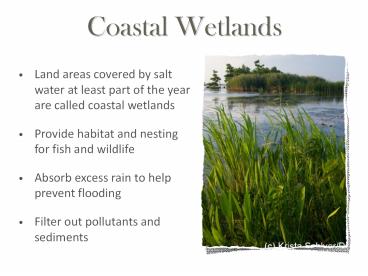Coastal Wetlands - PowerPoint PPT Presentation
Title:
Coastal Wetlands
Description:
Title: PowerPoint Presentation Author: Karen D. Spradlin Last modified by: vci Document presentation format: Custom Other titles: Helvetica Light Arial Noteworthy ... – PowerPoint PPT presentation
Number of Views:789
Avg rating:3.0/5.0
Title: Coastal Wetlands
1
Coastal Wetlands
- Land areas covered by salt water at least part of
the year are called coastal wetlands - Provide habitat and nesting for fish and wildlife
- Absorb excess rain to help prevent flooding
- Filter out pollutants and sediments
2
Plants and Animals of Estuaries
- Estuaries support many marine ecosystems
- Rivers supply nutrients that have washed from the
land - Sunlight and nutrients support large populations
of plants and plankton - Larger marine animals feed from estuaries
3
Threats to Estuaries
- In populated areas, they were used as landfills
- Pollutants include sewage, industrial waste, and
agricultural runoff - Estuaries cannot cope with the excessive amounts
of human pollution
4
Salt Marshes
- In estuaries, where rivers deposit mineral rich
mud, salt marshes form - Salt marshes support communities of clams, fish,
and aquatic birds - Act as a nursery for shrimp, crabs, fish which
are then consumed by other ocean animals or people
5
Mangrove Swamps
- Mangroves are several species of small trees
adapted for growing in shallow salt water - Mangroves have wide, above-ground root systems
for support - Dense growth of mangroves in swampy areas are
mangrove swamps - They help protect the coastline from erosion
6
Rocky and Sandy Shores
- Rocky shores have more plant and animal diversity
than sandy shores - Rocks anchor seaweed, sea anemone, mussels, and
sponges - Sandy shores has abundant life in the water and
sandy sediments - Barrier islands run parallel to sandy shores and
protect the mainland from storms
7
Coral Reefs
- Coral reefs are limestone ridges built by tiny
coral animals called coral polyps that secrete
skeletons of limestone that slowly accumulate
into reefs - Thousands of species of marine plants and animals
live in the cracks of reefs making them among the
most diverse ecosystems on Earth - Are only found in shallow, warm salt water
8
Coral Reefs in Danger
- Coral reefs are fragile ecosystems
- If the water gets too hot, too cold, too polluted
for too long, the algae that live there will move
or die--when this happens, the coral turns white
and is known as coral bleaching - Bleaching is occurring more frequently now
because of human activity
9
Oceans
- Sunlight penetrates only about 100 m (330 ft)
- As a result, much of the ocean's life is
concentrated here - Seaweed and algae grow anchored to rocks and
phytoplankton drift on the surface
10
Plants and Animals of Oceans
- Phytoplankton grows only where there is enough
sunlight and nutrients - This makes the open ocean one of the least
productive ecosystems - Phytoplankton use oils and air bubbles to keep
from sinking to the bottom - The smallest herbivores (jelly fish shrimp, fish
larvae) live near the phytoplankton they eat
11
Deeper in the Ocean
- The depths of the ocean are perpetually dark
- Most of the food is dead organisms
- Decomposers and filter feeders will be found here
12
Threats to the Ocean
- Oceans are steadily becoming more polluted
- Runoff from fertilized fields may cause algal
blooms - Waste from cities and industries, fertilizers,
and sewage are the main sources of pollution - Overfishing is destroying some fish populations
13
Arctic and Antarctic Ecosystems
- Ecosystems are marine
- The Arctic Ocean is nutrient rich because of
surrounding land masses - The Antarctic is the only continent never
colonized by humans - Plankton is the basis for both of these food webs
14
Copy Now, Answer Later
- Explain why estuaries are very productive
ecosystems. Why are estuaries vulnerable to the
effects of pollution? - Compare salt marshes with mangrove swamps.
- Describe two factors that can damage coral reefs.
- List two ways in which animals of the oceans are
threatened. - Suppose the sea suddenly rose 100 m. What would
happen to the world's coral reefs? Explain.































